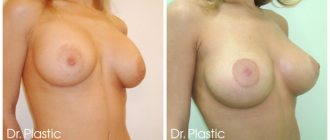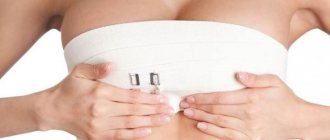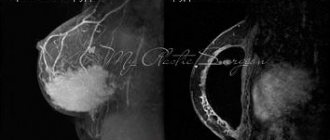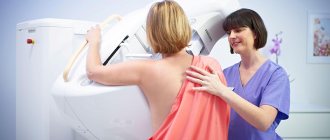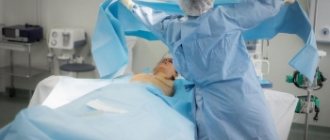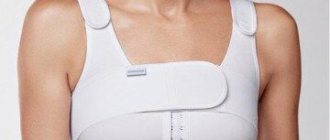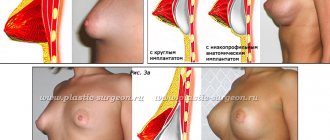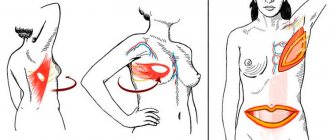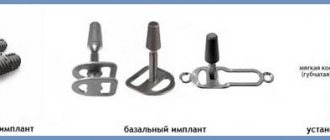Girls who decide to undergo mammoplasty - bust enlargement or correction using silicone implants, first of all, do not want to see additional scars on the body. This requirement determines the high aesthetics of plastic surgery. However, it is important to understand that you cannot do without scars.
Proper care of sutures after surgery is the basis for a quick recovery after surgery. Plastic surgeons pay special attention to this point of the rehabilitation program. Although this process is individual for each patient, there are general recommendations for care.
We will talk about the modern technology of “suture gluing”, how to properly care for scars, how you can speed up their healing, and show what scars look like after breast augmentation at different stages of rehabilitation.
Sutures after mammoplasty: their types and features
To install breast implants, a plastic surgeon needs to create access - make a tissue incision in the selected location. Please note that the choice of access is always determined individually during a consultation. All nuances are taken into account: the initial condition of the mammary gland, height and weight.
When performing breast augmentation, the incision is made in those areas where it will be as invisible as possible: in the inframammary fold, along the lower edge of the areola or through the armpit.
In aesthetic plastic surgery, three types of approaches for breast augmentation are common:
- submammary (the incision passes under the bust in a natural fold of the skin). This access is considered the most universal. The seams after mammoplasty in this area are invisible and are well hidden by underwear;
- periareolar (incision is made along the lower border of the areola). The border between light and dark skin allows the seams to have an aesthetic appearance and quickly become invisible;
- axillary (access is performed in the axillary area). This method for installing implants is often called “sutureless.” The seam in the armpit after healing almost completely merges with the natural color of the body. And, of course, there are no scars on the chest.
Sutures after mammoplasty are a thin cosmetic suture that tightens the edges of the surgical wound for speedy healing. There are several types:
- normotrophic. They represent an area of skin that is slightly lighter than the base color of the fabric and cannot be felt at all when touched. To ensure that the seams are completely even in shade, cosmetic peeling or laser resurfacing of scars using the latest generation Fotona laser is sufficient;
- hypertrophic. These scars are pink in color and protrude slightly above the surface of the skin. To completely smooth them out, peelings and laser resurfacing are used;
- keloids. These are the most difficult stitches after mammoplasty. Outwardly, they look rough, compacted, stand out with pigmentation and can be painful when touched.
Treatment of rough scars
Treatment of rough scars can be either medicinal or surgical.
Surgical treatment involves excision of the scar with plastic surgery using local tissue. There are many methods of scar plastic surgery, which are selected for each specific case.
Drug treatment includes wearing special patches and using ointments that block the excessive formation of connective tissue.
In particularly severe cases, when the scar continues to hypertrophy, glucocorticoid drugs are used in injection form. Such drugs must be used carefully so as not to transform a hypertrophic scar into an atrophic one.
Why do keloid scars appear?
Keloid scars are a complication of breast augmentation. Among the reasons for their formation are the following:
- features of the body's immune system,
- hereditary predisposition,
- excessive skin tension in the healing zone,
- suppuration or infection of a postoperative wound.
It should be noted that sutures after mammoplasty rarely turn into keloids. This process mainly has a hereditary predisposition and manifests itself gradually, in some cases up to 2 years. Therefore, with constant monitoring by a doctor, you can notice changes occurring in time and stop their development.
How to prevent the double breast effect
The most important thing for preventing such complications during mammoplasty is choosing an experienced surgeon who will take into account all the anatomical features of the breast and correctly develop surgical tactics. The experience and qualifications of the specialist are important, as well as the clinic’s equipment, implants of different types and sizes, which are individually selected for each patient.
A competent specialist will determine the future location of breast implants, the method of their installation and the area of incisions.
You first need to conduct a full examination before surgery, as well as meticulous adherence to the milestones of rehabilitation and medical recommendations.
It is also important to wear compression garments to prevent the prosthesis from drooping and to form the correct bed for it. Underwear will need to be selected together with the doctor and worn exactly as long as the doctor deems necessary.
Seam gluing during breast augmentation
Today, plastic surgery is developing exponentially. And the main goal of a plastic surgeon is to make scars as invisible as possible. Specialists use innovative technology of “seam gluing”. Its essence lies in the use of special medical glue for the skin. By the way, the seam gluing technique is often called the “seamless method of breast augmentation.” How does this happen?
In the operating room, the plastic surgeon applies a cosmetic suture to the wound using absorbable suture. This is an important point! Do not believe if they tell you that the edges of the wound will only be glued together with glue. There are always stitches! This is usually an absorbable thread, so the stitches are not removed after breast augmentation.
Only a stitched wound can be sealed by a plastic surgeon with glue. It is applied to the seam. In fact, medical glue acts as a kind of “plaster” that protects the wound and suture.
Advantages of seam gluing after mammoplasty:
- maximum protection of the seam from the external environment, bacteria and weathering;
- the seams do not require care;
- obtaining a high aesthetic result.
The scar after breast augmentation, made using the “suture gluing” technique, looks the same after 1 month as it did after 6-8 months. By the way, seam gluing is used for a tummy tuck (abdominoplasty).
Prevention of scar formation
- During the operation, try to minimize the tension on the postoperative sutures. Of course, the very meaning of a brace contradicts this, but we must remember that the tension should be reasonable.
- Breast lifts larger than size 4 will typically have more tension and therefore rougher scarring.
- Careful handling of soft tissues during surgery. It depends entirely on the surgeon.
- Careful suturing of the postoperative wound. Also, the care of the surgeon, but not always the most careful suturing of a postoperative wound guarantees a high-quality scar.
How to reduce a scar after mammoplasty?
If you still have scars after breast surgery that are not aesthetically pleasing to you, then you can resort to reducing them. Often girls turn to cosmetologists who offer procedures that can reduce the appearance of scars. These are peelings, microdermabrasion and laser resurfacing. Today, patients are most often offered laser scar resurfacing - this is the most reliable method of eliminating them. For example, you can do resurfacing using the latest generation Fotona laser.
FAQ
What to do with training if pain occurs?
You can continue to exercise, but exercises that cause pain should be avoided for a while.
If sharp painful sensations or significant discomfort appear, you need to stop all training and see a doctor.
Chest discomfort during exercise, what is the reason?
During the first 2-3 weeks, discomfort is acceptable. It is especially pronounced if a larger implant is inserted. The surgeon inserts it under the large chest muscle, where there is not enough room. The implant puts pressure on the surrounding tissue, stretching it. Over time, adaptation occurs.
To get the breasts of your dreams, work with reputable plastic surgeons. Butko Plastic will conduct an examination and the doctor will select implants. We use safe anesthesia and modern equipment. We use only proven developments. Call and make an appointment with Igor Butko now. Take the first step towards the breasts of your dreams.
Pain after surgery
Many girls worry about the sensations that may occur after breast augmentation. They are afraid of pain. In fact, there is no pain, there is discomfort, which can be compared to soreness after playing sports. There are also limitations in hand mobility. Immediately after the operation, it is difficult to raise your arms up, put on a jacket on your own, or even cut bread. But over time, this discomfort fades away.
In the early postoperative period, the breast remains swollen, there is a feeling of numbness, and there may also be “squelching” in the mammary gland.
Which patients are at risk?
Women from certain categories who have features in the anatomy of the mammary gland are especially at risk of encountering such a complication of mammoplasty:
- Tubular-shaped breasts with a too narrow base and a large areola, an inflated location of the inframammary fold against the background of a large volume of glandular tissue in the area of the upper pole of the gland.
- The breast is cone-shaped with a gland that is much wider than the area of the nipple and areola (shaped like a pyramid).
- The folds under the bust are sharply exaggerated.
- There is a congenital and quite pronounced asymmetry of the mammary glands, which sharply increases the risk of errors during surgical intervention if the calculations and selection of implants are carried out incorrectly.
How to care for seams?
Every patient, before stepping into the operating room, must understand that thin and barely noticeable scars after surgery will remain in any case. But thanks to proper and careful care, they can be made unnoticeable. Here is a list of basic recommendations on how to handle sutures after mammoplasty:
- Smoking is strictly not recommended during the period of preparation for the intervention and until final rehabilitation.
- It is mandatory to wear compression garments for up to six weeks after the surgical procedure.
- During the first week, contact with water is prohibited - the sutures after mammoplasty must be kept dry during this period.
- After hygiene procedures, it is necessary to apply a moisturizing cream or lotion to the stitches to avoid drying out the skin and to maintain its elasticity.
- For the first 2 months after surgery, physical activity on the shoulder girdle of muscles should be limited.
Reasons for the development of complications
Plastic surgeons identify a number of reasons for the development of double bubble folds. These can be complications both in the early stages after surgery (during the first two months) and late (in the period from 2 to 5 months after the intervention).
Causes of early defects:
- insufficient experience or qualifications of the operating plastic surgeon;
- choice of low quality prostheses, incorrect selection of size or shape for a particular woman;
- incorrect performance of the operation from the technical side, the wrong place for placing the implants was chosen;
- during the intervention, part of the fat layer was removed in the area of the submammary fold, where a cavity was subsequently formed into which the implant was lowered;
- the skin on the chest and chest is elastic and thin, while the fold area under the breast is quite convex;
- before plastic surgery, the woman had a pronounced asymmetry of the folds under the breast, which was not taken into account in advance by the surgeon when choosing tactics and the type of endoprostheses;
- the woman did not follow the recommendations during the rehabilitation period (refused to wear shapewear, slept on her stomach, started physical activity early).
In the later period, the development of such a complication is due to:
- slipping of the implant from its place due to various circumstances, which causes a “waterfall effect” with the nipple and areola of the breast lowering below the normal line with their deformation;
- displacement of the implant below the fold under the breast due to deformation of the prosthesis itself with its contouring under the skin;
- arbitrary migration of the implant in the pocket created by the surgeon;
- the presence of a congenital breast defect with underdevelopment of its lower pole;
- violation of the tactics of choosing a prosthesis in relation to its shape, type and size, as well as the anatomical features of the breast and surrounding tissues of the patient;
- the formation of a capsule of fibrous tissue around the prosthesis, compressing the product and displacing it downward, towards less tissue resistance.
Prohibitions
The rehabilitation period imposes some restrictions on a woman. Some of them depend on the individual characteristics of the patient’s body. The part is common to most women.
It is forbidden:
- perform active movements with your hands;
- lift weights;
- visit saunas, baths, solariums, swimming pools;
- supercool;
- smoke;
- take contraceptives;
- eat unhealthy foods.
In my opinion, there is nothing complicated about these prohibitions. However, failure to follow these rules may negate the effect of mastopexy.
It is important that already at the stage of making an appointment for a consultation you understand that ideal breasts are painstaking joint work between the doctor and the patient. You must choose a period when all these restrictions are possible. And then everything will go great!
Stages and deadlines
The path to ideal breasts does not end with surgery. The patient suffered anesthesia, blood loss, and invasion of the body. Therefore, she needs rest and care to recover.
The recovery process after mastopexy is divided into several periods:
1. Early recovery
It begins immediately after surgery. While the woman recovers from anesthesia, she is monitored by an anesthesiologist and nurses.
On the first day, bed rest is indicated. The patient is resting. The clinic staff monitors her condition and gives her the necessary medications.
After the operation, the patient spends one to three days in the hospital. This time can be difficult. A woman is worried about pain and discomfort after anesthesia. She feels weak, often dizzy and nauseated.
2. Healing period of sutures
After the sutures are removed (if necessary), a more active period begins. The patient is already at home and is monitoring herself independently. Its main task is to correctly follow the doctor’s recommendations.
3. Final recovery period
Rehabilitation after mastopexy takes several months. The timing depends on the characteristics of the patient. On average, full recovery occurs within six months.
